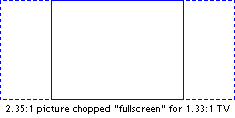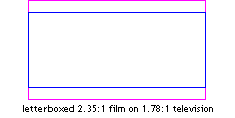Widescreen vs. Fullscreen
Originally published Monday, December 11, 2006
Since I work in a video store, I am often required to explain things to confused customers. Thankfully I have at least a general working knowledge of both our products and the technologies on which they depend. One area of major confusion for many consumers, even after decades of home video sales, is the concept of “Widescreen” releases versus “Fullscreen” releases. Sadly, the recent prevalence of Widescreen television sets has only compounded the issue. This is an attempt to explain the difference.
The first question I invariably get yields the quickest and easiest answer: "If I play a Widescreen movie on my regular television, will I get those black bars on the screen?" Yes. And the follow-up question, of course: "So if I buy the Fullscreen version, it will take up the full screen?" Yes. Usually that is enough to make the purchase decision right then and there. Occasionally I will get the follow-up to the follow-up question, which is the one I am waiting for because I can then try to convince the customer not to make a mistake: "Why do they put those bars on the screen? I hate that!"
These customers assume that, because they are seeing black space on the screen, they are missing something. It's an understandable confusion, but in fact it's the exact opposite. This is the spiel that I usually unravel:
The problem is that your television is not the same shape as the movie. Televisions were traditionally built with an aspect ratio of roughly 1.33:1. In plain English, imagine that your TV screen is 12 inches high. Given the ratio of television viewing, it is therefore going to be roughly 16 inches across. The cameras that are used to shoot television shows and home movies anticipate this, and are set up to capture a picture that fits those dimensions.

Movies, however, are not shot that way. When you see a film in a theater, you will notice that the picture is much wider across than it is tall. There are two main aspect ratios that films are shot in: 1.85:1 and 2.35:1 (approximately). Using the same 12-inch-high example, the picture is now going to be roughly either 22 or 28 inches across, depending on which film options the filmmakers have chosen.


So as you can see, 22 or 28 inches of film picture would be much wider than the 16 inches of the television. The problem is now, how to fit the picture on a screen that's shaped differently?
Think of it like a printed photograph: You have a panoramic photo (the movie) that you are trying to fit in a 4x6 frame (the TV). It is simply not going to work, so you are going to have to change something. The quickest solution, if you're using a panoramic photo, is to cut the edges off. This is basically what happens on a "Fullscreen" video: The sides of the image are cropped, and now it will fit fully on the TV screen. But you probably wouldn't cut the edges off your panoramic photos, would you? There are probably elements in the photograph that you would lose, and what would be the point of having a panoramic shot in the first place? This is the problem with Fullscreen: yes it fits nicely on the TV, but unfortunately you are no longer seeing the full picture.

Another solution is to shrink the panoramic photo down so that its length fits in the frame. Now you can see the whole picture, but unfortunately it is smaller and there is a lot of empty space within the frame. This is essentially what is happening on a "Widescreen" video: The full film picture is visible, but it is scaled down to fit within the TV screen width. The empty space is rendered as the least-distracting thing possible: a large expanse of black above and below the picture (this is known as letterboxing).

So, if you are using a standard television, those are your choices: A Fullscreen picture with part of the image missing, or a Widescreen picture with a full image that doesn't take up the whole screen. If you are the type to mutilate your panoramic photos, thus rendering them non-panoramic and possible omitting that really cool cloud formation in the center, by all means choose Fullscreen. Personally, I appreciate the artistry and craft of film making and would rather deal with the black bars on the screen. If you feel the image is too small, you can always buy a bigger TV. (wink)
Now, recently I was asked by a customer, "I bought a Widescreen TV so that I could watch Widescreen movies, and I still get the damn black bars on the screen!" Now that Widescreen TV is becoming more popular, it actually makes things more confusing by adding a whole new level of complexity.
Widescreen TVs are neither 1.85:1 nor 2.35:1. Instead, they are a seemingly arbitrary 1.78:1 aspect ratio. Using our 12-inch-high screen example, that creates a width of roughly 21 inches. This is no problem when it comes to Widescreen television broadcasts: When you watch your Desperate Housewives, it's been shot for broadcast on a 1.78:1 Widescreen TV.

But of course, that's still not as wide as either of the two common film ratios, so the problem still exists. And yes, you are therefore going to still be getting the "dreaded" black bars on the screen, unless your Widescreen TV has features that will stretch and blend the image to the full height.

(This is dependent on your TV model and make, and the details of the release on DVD. Is it an anamorphic transfer? If yes, can your TV support that? If yes again, then you're in luck. If not, then you may even have to deal with bars on the side of the image as well…)
Hopefully this explanation has shed some light on the problem. It is in no way a complete explanation, since there are dozens of aspect ratios used on films throughout the last century, and of course it only applies to films viewed on TVs in the United States and Canada. It also doesn't take into account the similar problems when viewing standard television programs on a Widescreen TV… or movies filmed before the 1950s (when the format was more commonly closer to that of standard television dimensions)… or Fullscreen DVDs of Widescreen TV shows from England viewed on a standard US television…
As you can see, the problem can increasingly be compounded by an order of magnitude when you take into account the seemingly limitless variables between television and film sizes. Even my relatively simple explanation is exceedingly long! But long story short: Widescreen—good. Fullscreen—bad. Black bars—not as bad as you think.
(EDIT: Ok, it's really not nearly as simple as that, for a variety of reasons that are explored in some of the comments below. Also I did not really go into a full explanation of anamorphic Widescreen transfers vs standard letterbox…)
Happy viewing.